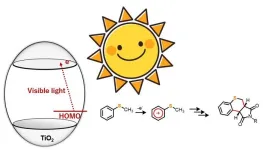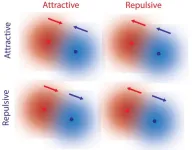(Press-News.org) Just like a doctor adjusts the dose of a medication to the patient’s needs, the expression of therapeutic genes, those modified in a person to treat or cure a disease via gene therapy, also needs to be maintained within a therapeutic window. Staying within the therapeutic window is important as too much of the protein could be toxic, and too little could result in a small or no therapeutic effect.
Although the principle of therapeutic window has been known for a long time, there has been no strategy to implement it safely, limiting the potential applications of gene therapy in the clinic. In their current study published in the journal Nature Biotechnology, researchers at Baylor College of Medicine report on a technology to effectively regulate gene expression, a promising solution to fill this gap in gene therapy clinical applications.
“Although there are several gene regulation systems used in mammalian cells, none has been approved by the U.S. Food and Drug Administration for clinical applications, mainly because those systems use a regulatory protein that is foreign to the human body, which triggers an immune response against it,” said corresponding author Dr. Laising Yen, associate professor of pathology and immunology and of molecular and cellular biology at Baylor. “This means that the cells that are expressing the therapeutic protein would be attacked, eliminated or neutralized by the patient’s immune system, making the therapy ineffective.”
For more than a decade, Yen and his colleagues have been working on this technology and now they have found a solution to overcome the main obstacles in its clinical use. “The solution we found does not involve a foreign regulatory protein that will evoke an immune response in patients. Instead, we use small molecules to interact with RNA, which typically do not trigger an immune response,” Yen said. “Other groups also have made attempts to resolve this critical issue, but the drug concentrations they used are beyond what the FDA has approved for patients. We were able to engineer our system in such a way that it works at the FDA-approved dosage.”
A switch to turn genes on/off on cue
Yen and his colleagues developed a system that turns genes on to different levels on cue using small molecules at FDA-approved doses. The switch is placed in the RNA, the copy of genetic material that is translated into a protein. This approach allows the researchers to control the protein’s production a step back by controlling its RNA.
The RNA of interest is first engineered to contain an extra polyA signal, akin to a “stop sign” that genes naturally use to mark the end of a gene. When the machinery of the cell detects a polyA signal in the RNA, it automatically makes a cut and defines the cut point as the end of the RNA. “In our system, we use the added polyA signal, not at the end, but at the beginning of the RNA, so the cut destroys the RNA and therefore the default is no protein production. It is turned off until we turn it on with the small molecule,” Yen said.
To turn on the gene at the desired level, the team engineered a switch on the RNA. They modified a section of the RNA near the polyA signal such that it can now bind to a small molecule, FDA-approved tetracycline in this case. “When tetracycline binds to that section that functions as a sensor on the RNA, it masks off the polyA signal, and the RNA will now be translated into protein,” Yen said.
Imagine the now possible future situation. A patient has received gene therapy that provides a gene to compensate for a malfunctioning gene that causes a medical condition. The gene the patient received has the switch, which allows the physician to control the production of the therapeutic protein. If the patient only requires a small amount of the therapeutic protein, then he/she will only take a small dose of tetracycline, which will turn on the therapeutic gene only a little. If the patient needs more therapeutic protein, then he/she would take more tetracycline to boost production. To stop production of the therapeutic protein, the patient stops taking tetracycline. In the absence of tetracycline, the switch will be back to its default off position. Some diseases may benefit from the presence of constant low levels of therapeutic protein. In that case, the technology has the flexibility to pre-adjust the default level to specified levels of protein expression while retaining the option of dialing up the expression with tetracycline.
“This strategy allows us to be more precise in the control of gene expression of a therapeutic protein. It enables us to adjust its production according to disease’s stages or tune to the patients’ specific needs, all using the FDA-approved tetracycline dose,” Yen said. “Our approach is not disease-specific, it can theoretically be used for regulating the expression of any protein, and potentially has many therapeutic applications. In addition, this system is more compact and easier to implement than the existing technologies. Therefore, it also can be very useful in the lab to turn a gene of interest on or off to study its function.”
Liming Luo, Jocelyn Duen-Ya Jea, Yan Wang and Pei-Wen Chao, all at Baylor College of Medicine, also contributed to this work.
This work was supported by an E&M Foundation Pre-Doctoral Fellowship for Biomedical Research, NIH grants (R01EB013584, UM1HG006348, R01DK114356, R01HL130249, P30 CA125123 and S10 RR024574), Biogen SRA, seed fund from Department of Pathology and Immunology at Baylor College of Medicine and CPRIT Core Facility Support Award CPRIT-RP180672.
###
END
A novel switch to turn genes on/off on cue, a promising step toward safer gene therapy
2024-01-02
ELSE PRESS RELEASES FROM THIS DATE:
Food insecurity among low-income adults dropped nearly 5% during pandemic-era SNAP expansion
2024-01-01
Embargoed for release until 5:00 p.m. ET on Monday 1 January 2024
Annals of Internal Medicine Tip Sheet
@Annalsofim
Below please find summaries of new articles that will be published in the next issue of Annals of Internal Medicine. The summaries are not intended to substitute for the full articles as a source of information. This information is under strict embargo and by taking it into possession, media representatives are committing to the terms of the embargo not only ...
A tidy cell seems to keep aging at bay
2024-01-01
Osaka, Japan – Just as healthy organs are vital to our well-being, healthy organelles are vital to the proper functioning of the cell. These subcellular structures carry out specific jobs within the cell, for example, mitochondria power the cell and lysosomes keep the cell tidy.
Although damage to these two organelles has been linked to aging, cellular senescence, and many diseases, the regulation and maintenance of these organelles has remained poorly understood. Now, researchers at Osaka University have identified a protein, HKDC1, that plays a key role in maintaining these two organelles, thereby acting to prevent ...
Chemical synthesis using titanium dioxide: An eco-friendly and innovative approach
2024-01-01
Heterocyclic compounds are organic molecules with a ring structure comprising at least two or more elements. In most cases, these rings are composed of carbon atoms along with one or more other elements such as nitrogen, oxygen, or sulfur. They are highly sought-after as raw materials in the chemical and pharmaceutical industry, owing to their versatility and excellent physiological activities. While several methods are available for synthesizing these compounds, most of them involve high temperature and pressure conditions, or the use of precious ...
Want to quit smoking in 2024? Cytisine can help … if you live in the right country
2024-01-01
A new study published in Addiction has found that cytisine, a low-cost, generic stop-smoking aid that has been used in eastern Europe since the 1960s, increases the chances of successful smoking cessation by more than two-fold compared with placebo and may be more effective than nicotine replacement therapy. It has a benign safety profile, with no evidence of serious safety concerns. Sounds perfect for your New Year resolution, doesn’t it? But there’s a catch: Cytisine is not licensed or marketed in most countries outside of central and eastern Europe, ...
Sodium’s high-pressure transformation can tell us about the interiors of stars, planets
2023-12-29
Travel deep enough below Earth’s surface or inside the center of the Sun, and matter changes on an atomic level.
The mounting pressure within stars and planets can cause metals to become nonconducting insulators. Sodium has been shown to transform from a shiny, gray-colored metal into a transparent, glass-like insulator when squeezed hard enough.
Now, a University at Buffalo-led study has revealed the chemical bonding behind this particular high-pressure phenomenon.
While it’s been theorized that high pressure essentially squeezes sodium’s electrons out into the spaces between atoms, researchers’ quantum chemical ...
Endocrine Society applauds Ohio governor veto of state ban on gender-affirming care for minors
2023-12-29
WASHINGTON—The Endocrine Society, the world’s oldest and largest professional medical society devoted to the study and treatment of hormone-related conditions, applauds Governor Mike Dewine’s veto of a proposed Ohio law that would have banned gender-affirming care for minors. The bill he vetoed contradicts mainstream medical practice and scientific evidence and would have taken medical decision-making out of the hands of families and their physicians and instead relied upon government officials.
More ...
Molecules exhibit non-reciprocal interactions without external forces, new study finds
2023-12-29
Researchers from the University of Maine and Penn State discovered that molecules experience non-reciprocal interactions without external forces.
Fundamental forces such as gravity and electromagnetism are reciprocal, where two objects are attracted to each other or are repelled by each other. In our everyday experience, however, interactions don’t seem to follow this reciprocal law. For example, a predator is attracted to prey, but the prey tends to flee from the predator. Such non-reciprocal interactions are essential for complex behavior associated with living organisms. ...
MSK research highlights, December 29, 2023
2023-12-29
New research from Memorial Sloan Kettering Cancer Center (MSK) developed CAR T cells that target two acute myeloid leukemia-specific antigens; shed new light on a genetic element called LINE-1, opening the door to new treatments; identified a key regulator of blood stem cell fate; and found an immunotherapy technique using antibodies that target CD47 shows promise in mice.
CAR T Cells that target two antigens treat AML with minimal toxicity
Acute myeloid leukemia (AML) has so far resisted treatment with chimeric ...
Novel solution for Pichia pastoris enzyme production platform
2023-12-29
The demand for industrial enzymes is continually rising, driven by the growing need to shift towards more sustainable industrial processes. Our research outlines a novel approach in enzyme production, harnessing the untapped potential of cyanobacterial biomass within the P. pastoris platform. Group Leader, Dr. Schieder, highlights the nature of the study, stating, "Our work reveals the potential of cyanobacterial biorefineries to support enzyme production."
This achievement stems from an extensive multi-field approach. We characterized and expanded a combinatorial library, streamlining P. pastoris engineering for enhanced efficiency. ...
Revolutionary nanodrones enable targeted cancer treatment
2023-12-29
A groundbreaking study led by Professor Sebyung Kang and Professor Sung Ho Park in the Department of Biological Sciences at UNIST has unveiled a remarkable breakthrough in cancer treatment. The research team has successfully developed unprecedented “NK cell-engaging nanodrones” capable of selectively targeting and eliminating cancer cells, offering a potential solution for intractable types of cancers.
The innate lymphoid cells known as natural killer (NK) cells play a vital role in the body’s immune response against cancer. Numerous efforts have been made to harness the power of NK cells to develop effective cancer therapies. ...





